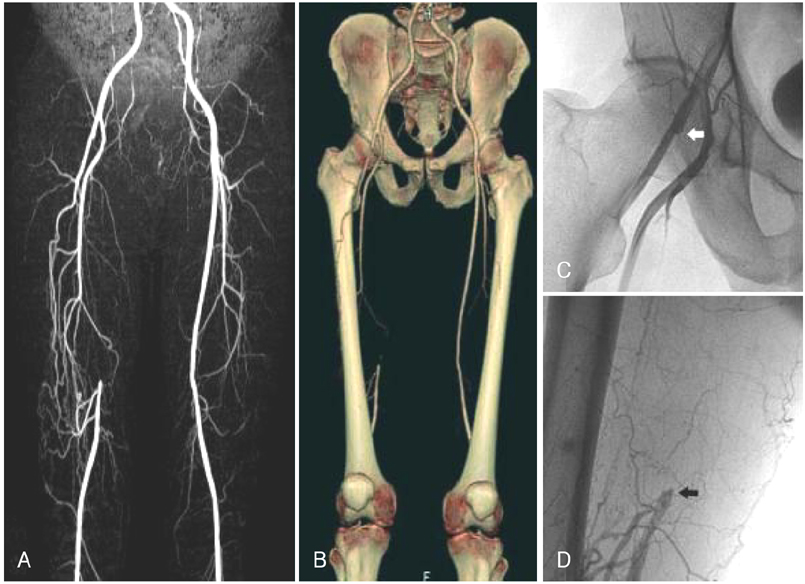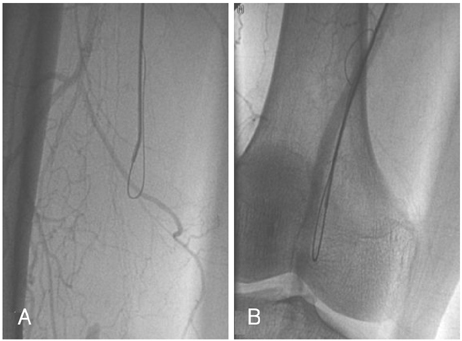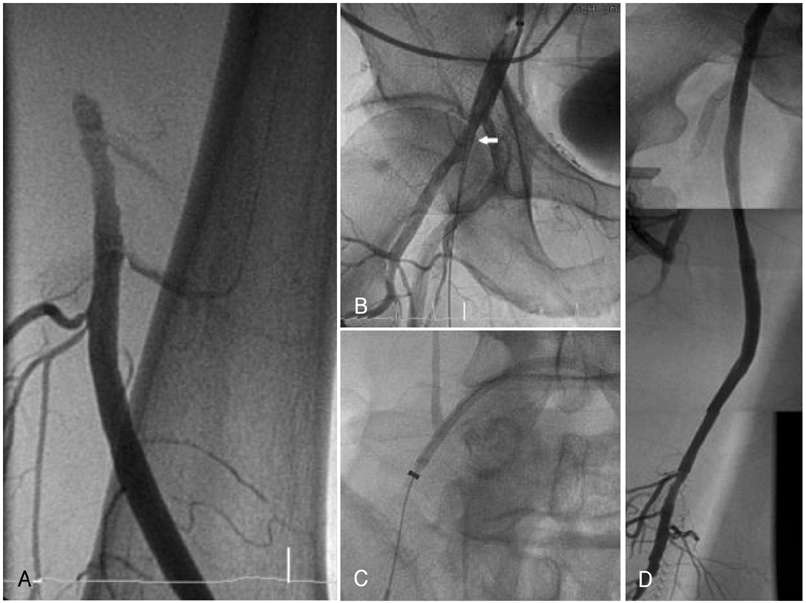Korean Circ J.
2008 Oct;38(10):557-560. 10.4070/kcj.2008.38.10.557.
Successful Recanalization of a Long Superficial Femoral Artery Occlusion by Retrograde Subintimal Angioplasty After a Failed Antegrade Subintimal Approach
- Affiliations
-
- 1Division of Cardiology, Department of Internal Medicine, Soonchunhyang University College of Medicine, Bucheon Hospital, Bucheon, Korea. naeheelee@paran.com
- KMID: 2225721
- DOI: http://doi.org/10.4070/kcj.2008.38.10.557
Abstract
- The primary success rate of intraluminal angioplasty for long superficial femoral artery (SFA) occlusions is low due to the long occlusion length and the hard component of the occlusion. To overcome this problem, subintimal angioplasty has been previously proposed and this technique is now considered as an effective method for the treatment of SFA occlusions. Subsequently, various devices and strategies have been developed to increase the success rate of subintimal angioplasty for SFA occlusions. Here, we present a case in which a long chronic total occlusion of SFA was successfully recanalized by the retrograde subintimal angioplasty through the popliteal artery after the failed antegrade subintimal approach.
MeSH Terms
Figure
Cited by 1 articles
-
Intraoperative Balloon Angioplasty in Diabetic Foot with Peripheral Artery Occlusive Disease During Amputation - Two Case Reports -
Yun Tae Lee, Seong Min Kim, Ju Hyung Yoo, Hyun Cheol Oh, Joong-Won Ha, Seung Yong Sung, Jee-Hoon Chang, Han Kook Yoon
J Korean Orthop Assoc. 2009;44(5):575-579. doi: 10.4055/jkoa.2009.44.5.575.
Reference
-
1. Bolia A, Miles KA, Brennan J, Bell PR. Percutaneous transluminal angioplasty of occlusions of the femoral and popliteal arteries by subintimal dissection. Cardiovasc Intervent Radiol. 1990. 13:357–363.2. Reekers JA, Bolia A. Percutaneous intentional extraluminal (subintimal) recanalization: how to do it yourself. Eur J Radiol. 1998. 28:192–198.3. Lee SH, Choi D, Ko YG, et al. The outcome of percutaneous intervention of the superficial femoral artery and the predictors of its patency. Korean Circ J. 2003. 33:607–613.4. London NJ, Srinivasan R, Naylor AR, et al. Subintimal angioplasty of femoropopliteal artery occlusions: the long-term results. Eur J Vasc Surg. 1994. 8:148–155.5. Casserly IP, Sachar R, Bajzer C, Yadav JS. Utility of IVUS-guided transaccess catheter in the treatment of long chronic total occlusion of the superficial femoral artery. Catheter Cardiovasc Interv. 2004. 62:237–243.6. Hausegger KA, Georgieva B, Portugaller H, Tauss J, Starg G. The outback catheter: a new device for true lumen re-entry after dissection during recanalization of arterial occlusions. Cardiovasc Intervent Radiol. 2004. 27:26–30.7. Heenan SD, Vinnicombe SJ, Buckenham TM, Belli AM. Percutaneous transluminal angioplasty by a retrograde subintimal transpopliteal approach. Clin Radiol. 1994. 49:824–828.
- Full Text Links
- Actions
-
Cited
- CITED
-
- Close
- Share
- Similar articles
-
- Use of Retrograde Outback Catheter Through the Pedal Route in a Stumpless Long Superficial Femoral Artery Occlusion
- Strategies for Successful Percutaneous Revascularization of Chronic Total Occlusion of the Femoropopliteal Arteries When the Antegrade Passage of a Guide Wire Fails
- Retrograde Distal Superficial Femoral Artery Approach in the Supine Position for Chronic Superficial Femoral Artery Occlusion
- Target Balloon-Assisted Antegrade and Retrograde Approach for Recanalization of Thrombosed Fem-Pop Bypass Graft Using the Outback Catheter
- A Dual (Brachial and Contralateral Femoral) Approach for Subintimal Angioplasty of Long Ilio-Femoral Occlusive Disease Including the Iliac Ostium




